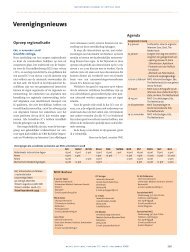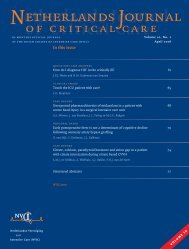Netherlands Journal
NJCC Volume 10, Oktober 2006
NJCC Volume 10, Oktober 2006
- No tags were found...
You also want an ePaper? Increase the reach of your titles
YUMPU automatically turns print PDFs into web optimized ePapers that Google loves.
netherlands journal of critical care<br />
pared to volatile anaesthetics - seems to be limited [61]. Interestingly,<br />
in experimental studies morphine was shown to enhance the efficacy<br />
of the cardioprotective response induced by volatile anaesthetics thus<br />
providing important clinical therapeutic options [43]. These observations<br />
may significantly contribute to the development of balanced<br />
anaesthesia techniques. Furthermore, it may be interesting to speculate<br />
how the anaesthesia technique may even exceed the purpose of<br />
cardioprotection and be extended to modulate the general response<br />
to surgical stress, thereby protecting several organ systems. It is interesting<br />
to realise that the choice of anaesthetic regimen can modify<br />
the cytokine production in response to surgery [69], and therefore<br />
the protection afforded may extend beyond the operating room.<br />
Interestingly, the observation that sevoflurane favourably alters the<br />
haemodynamic profile in septic rats (unpublished observations) may<br />
suggest that the choice of anaesthetics could influence the management<br />
of septic patients not only in the operating room but also in the<br />
intensive care unit.<br />
However, taking existing controversies upon the clinical induction<br />
of protection by anaesthetics into consideration, the need for<br />
large well-designed multi-centre trials in order to develop effective<br />
clinical cardioprotective strategies has been stressed by various investigators<br />
[70,71].<br />
Future directions<br />
The clinical relevance of preconditioning may be questioned for several<br />
reasons. Preconditioning-induced cardioprotection is elicited by<br />
applying a preconditioning stimulus before ischaemia and reperfusion<br />
will occur. In clinical practice, the occurrence of ischaemic episodes<br />
may often not be predicted. This is the reason that many investigators<br />
now focus on postconditioning, thereby applying the protective<br />
stimulus during the reperfusion phase. Recently, it was shown<br />
that brief ischaemic periods during the initial minutes of reperfusion<br />
afford the same amount of protection compared to preconditioning.<br />
Zhao et al. (2003) defined this phenomenon as ‘postconditioning’,<br />
although the beneficial effects of volatile anaesthetics during reperfusion<br />
have already been described in earlier studies [72,73]. Postconditioning<br />
seems to depend on similar signalling pathways to preconditioning,<br />
and was recently demonstrated to be cardioprotective<br />
in a clinical study performed by Staat et al. (2005) [74]. This study<br />
may be an important step in the development of clinical cardioprotective<br />
strategies that can be applied after the ischaemic phase.<br />
Preconditioning has been called a phenomenon of the healthy<br />
heart, as several studies have shown that the diseased heart is not<br />
effectively protected by preconditioning [75]. This is disappointing<br />
as diseased myocardium would benefit most from cardioprotective<br />
measures. Several studies aim to address this issue, however, our understanding<br />
remains limited. Therefore, studies with specific focus<br />
on the mechanism of cardioprotection in the diseased heart would<br />
greatly enhance the clinical potential.<br />
Finally, to date the use of volatile anaesthetics has mostly been<br />
limited to the operating theatre as most ICU ventilators do not meet<br />
the technical requirements for the safe application of these agents.<br />
Environmental pollution and the risk of occupational exposure have<br />
prevented the routine use of volatile anaesthetics in the ICU. Therefore,<br />
suitable ventilator systems that limit the risk of occupational<br />
exposure have to be developed in order to benefit from the protection<br />
of volatile anaesthetics in the ICU. Recent progress on volatile anaesthetic<br />
delivery systems for the ICU, such as the volatile anaesthetic<br />
reflection filter (AnaConDa ® ), are promising developments [76].<br />
In summary, the past two decades of cardiac research have greatly<br />
improved our understanding on the interaction of volatile anaesthetics<br />
and the ischaemic heart. This group of anaesthetics has been<br />
shown to trigger distinct cardioprotective signalling cascades, which<br />
provide the heart with an increased resistance to ischaemic episodes.<br />
Despite the increased understanding of the mechanisms responsible,<br />
our knowledge has to be extended in order to implement in the<br />
clinical situation. However, the results remain promising, and suggest<br />
a possible new therapeutic action for volatile anaesthetics.<br />
References<br />
1. Weber,NC and Schlack,W. The concept of anaestheticinduced<br />
cardioprotection: mechanisms of action. Best<br />
Pract Res Clin Anaesthesiol 2005;19:429-443.<br />
2. de Ruijter,W, Musters,RJP, Boer,C, Stienen,GJM,<br />
Simonides,WS, de Lange,JJ. The Cardioprotective Effect<br />
of Sevoflurane Depends on Protein Kinase C Activation,<br />
Opening of Mitochondrial K+ATP Channels, and the<br />
Production of Reactive Oxygen Species. Anesth Analg<br />
2003;97:1370-1376.<br />
3. Bouwman,RA, Musters,RJ, Beek-Harmsen,BJ, De Lange,JJ,<br />
Boer,C. Reactive oxygen species precede protein kinase<br />
C-delta activation independent of adenosine triphosphate-sensitive<br />
mitochondrial channel opening in<br />
sevoflurane-induced cardioprotection. Anesthesiology<br />
2004;100:506-514.<br />
4. Gordon,AM, Regnier,M, Homsher,E. Skeletal and cardiac<br />
muscle contractile activation: tropomyosin “rocks and<br />
rolls”. News Physiol Sci 2001;16:49-55.<br />
5. Hanley,PJ, ter Keurs,HE, Cannell,MB. Excitationcontraction<br />
coupling in the heart and the negative<br />
inotropic action of volatile anesthetics. Anesthesiology<br />
2004;101:999-1014.<br />
6. Hannon,JD and Cody,MJ. Effects of volatile anaesthetics<br />
on sarcolemmal calcium transport and sarcoplasmic<br />
reticulum calcium content in isolated myocytes .<br />
Anesthesiology 2002;96:1457-1464.<br />
7. Haworth,RA and Goknur,AB. Inhibition of sodium/calcium<br />
exchange and calcium channels of heart cells by<br />
volatile anesthestics. Anesthesiology 1995;82:1255-1265.<br />
8. Bouwman,RA, Salic,K, Padding,G, Eringa,EC, van Beek-<br />
Harmsen,BJ, Matsuda,T, et al. Cardioprotection via<br />
activation of protein kinase C-δ depends on modulation<br />
of the reverse mode of the Na+/Ca2+-exchanger.<br />
Circulation (Surgical Supplement) 2006; accepted for<br />
publication.<br />
9. Hanley,PJ and Loiselle,DS. Mechanisms of force inhibition<br />
by halothane and isoflurane in intact rat cardiac<br />
muscle. J Physiol 1998;506 ( Pt 1):231-244.<br />
10. Davies,LA, Gibson,CN, Boyett,MR, Hopkins,PM,<br />
Harrison,SM. Effects of isoflurane, sevoflurane, and<br />
halothane on myofilament Ca2+ sensitivity and sarcoplasmic<br />
reticulum Ca2+ release in rat ventricular<br />
myocytes. Anesthesiology 2000;93:1034-1044.<br />
11. Graham,MD, Bru-Mercier,G, Hopkins,PM, Harrison,SM<br />
. Transient and sustained changes in myofilament<br />
sensitivity to Ca2+ contribute to the inotropic effects of<br />
sevoflurane in rat ventricle. Br J Anaesth 2005;94:279-<br />
286.<br />
12. Kloner,RA and Jennings,RB. Consequences of brief<br />
ischaemia : stunning, preconditioning, and their clinical<br />
implications: part 1. Circulation 2001;104:2981-2989.<br />
13. Jennings,RB, Murry,CE, Steenbergen,C, Jr., Reimer,KA.<br />
Development of cell injury in sustained acute ischaemia<br />
. Circulation 1990;82:II2-12.<br />
14. Schafer,C, Ladilov,Y, Inserte,J, Schafer,M, Haffner,S,<br />
Garcia-Dorado,D, et al. Role of the reverse mode of the<br />
Na+/Ca2+ exchanger in reoxygenation-induced cardiomyocyte<br />
injury. Cardiovasc Res 2001;51:241-250.<br />
15. Vanden Hoek,TL, Li,C, Shao,Z, Schumacker,PT, Becker,LB.<br />
Significant levels of oxidants are generated by isolated<br />
cardiomyocytes during ischaemia prior to reperfusion .<br />
J Mol Cell Cardiol 1997;29:2571-2583.<br />
16. Kevin,LG, Novalija,E, Riess,ML, Camara,AKS, Rhodes,SS,<br />
Stowe,DF. Sevoflurane Exposure Generates Superoxide<br />
but Leads to Decreased Superoxide During Ischaemia<br />
and Reperfusion in Isolated Hearts. Anesth Analg<br />
2003;96:949-955.<br />
17. Piper,HM, Garcia-Dorado,D, Ovize,M. A fresh look at<br />
reperfusion injury. Cardiovasc Res 1998;38:291-300.<br />
18. Logue,SE, Gustafsson,AB, Samali,A, Gottlieb,RA. Ischaemia<br />
/reperfusion injury at the intersection with cell<br />
death. J Mol Cell Cardiol 2005;38:21-33.<br />
19. Kim,MS and Akera,T. O2 free radicals: cause of ischaemia<br />
-reperfusion injury to cardiac Na+-K+-ATPase. Am J<br />
Physiol 1987;252:H252-H257.<br />
20. Goldhaber,JI and Qayyum,MS. Oxygen free radicals and<br />
excitation-contraction coupling. Antioxid Redox Signal<br />
2000;2:55-64.<br />
21. Lazou,A, Seraskeris,S, Tsiona,V, Drossos,G. Oxidative<br />
status and anti-oxidant enzyme activity during calcium<br />
paradox in the rat isolated heart. Clin Exp Pharmacol<br />
Physiol 2000;27:160-166.<br />
22. Verdouw,PD, Remme,WJ, de Jong,JW, Breeman,WA.<br />
Myocardial substrate utilization and hemodynamics<br />
following repeated coronary flow reduction in pigs.<br />
Basic Res Cardiol 1979;74:477-493.<br />
23. Basuk,WL, Reimer,KA, Jennings,RB. Effect of repetitive<br />
brief episodes of ischaemia on cell volume, electrolytes<br />
and ultrastructure. J Am Coll Cardiol 1986;8:33A-41A.<br />
neth j crit care • volume 10 • no 5 • october 2006<br />
559







